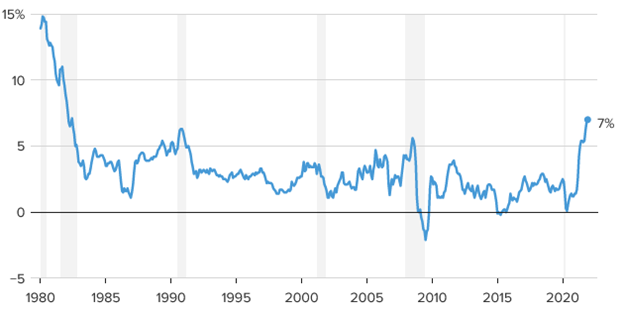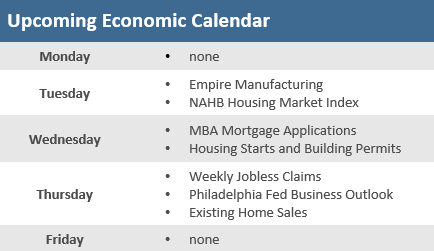Quick Takes
- Markets continued their shaky start to 2022 with a second straight week of losses, though the declines were much more moderate than the first week of trading in the new year. The S&P 500 and Nasdaq slipped -0.3%, while the small-cap Russell 2000 Index fell -0.8%.
- The U.S. 10-year Treasury note yield slowed its ascent from the first week but was still up another two basis points to 1.78%. The shorter-term 2-year Treasury gained more, up ten basis points in the week, pushing the yield curve flatter, which was a pattern for much of the fourth quarter of 2021.
- On balance, most economic data for the week was softer-than-expected. Retail sales came in far below economists’ forecasts, consumer sentiment declined more than expected, and industrial production and capacity utilization came in light.
2022’s shaky start continues with inflation in focus
Most major indexes fell for the second straight week but finished well off the lows of the week. It’s been a shaky start to 2022 after tech and growth stocks fell sharply in the first week of the year as the Fed shifts to a more aggressive policy stance to combat inflation. The primary gauge of consumer inflation, the Consumer Price Index (CPI), hit +7%, its highest annual rate since 1982. In his confirmation hearing before the Senate Banking Committee on Tuesday, Federal Reserve Chairman Jerome Powell expressed resolve on the fight against inflation without appearing panicked. Despite the headline-grabbing CPI report, other inflation measures came in somewhat softer. The Producer Price Index (PPI) is a measure of wholesale prices, which had been leading the CPI higher for months. But the December PPI came in under forecasts and lighter than November’s level. Likewise, the Labor Department reported that Import Prices also unexpectedly decreased in December, down from November’s rate, and the first decline since August of 2021. The slowdown in PPI and import prices provide some hope that the inflation surge may be peaking.
Other economic data for the week was softer-than-expected as well. Consumer sentiment declined more than expected, retail sales were well below economists’ consensus forecasts, and industrial production and capacity utilization came in light. The market’s focus in the coming week will turn toward fourth-quarter earnings, which are expected to be up about +22.4%, according to Refinitiv estimates, capping off a remarkable 2021 where overall earnings will be up approximately +49%. Corporate profits will be critical to keeping the market ascending. That 2021 earnings growth rate is bound to be a highwater mark, but 2022 is still shaping up to be a very healthy, single-digit growth year in line with historical averages.
Chart of the Week
The last time U.S. inflation was this high, the hot new personal computer was the Commodore 64, the U.S. government broke up AT&T, and E.T. and Fast Times at Ridgemont High were leading at the box office. The Consumer Price Index (CPI), the main inflation gauge of U.S. consumer goods, jumped +7% on an annual basis in December. That was the highest reading since 1982. The eighth straight month of consumer inflation is higher than +5%, and the third consecutive month above +6%. Meanwhile, the Producer Price Index (PPI), a measure of inflation for wholesale goods, was up +9.7% from last December, slightly below the record +9.8% annual rate recorded last month. In his confirmation hearing on Capitol Hill on Tuesday, Fed Chairman Jerome Powell emphasized that he will use all the central bank tools to get inflation back on track. “If we have to raise interest rates more over time, we will,” Powell told the Senate Banking Committee. “The economy no longer needs or wants the very accommodative policies we have had in place.”
Inflation Palpitations
Consumer Price Index (CPI), % change from a year ago
Note: Shaded areas indicate U.S. recessions.
Source: Bureau of Labor Statistics, CNBC. Seasonally adjusted.
Economic Review
- The advance Retail Sales report for December unexpectedly fell by -1.9% from November, far below the -0.1% dip forecasted and below November’s downwardly revised +0.2%. Sales ex-autos were even more disappointing, dropping -2.3% versus expectations for a +0.1% gain and November’s downwardly revised +0.1% increase. Sales declines were broad-based, with the major contributors to the drop coming from non-store retailers—which includes online activity—and department stores. Sales at home furnishings, electronics and appliances, clothing, and sporting goods stores also posted noticeable decreases.
- The December National Federation of Independent Business (NFIB) Small Business Optimism Index ticked slightly higher to 98.9 from November’s 98.4 level, versus the expectations for a rise to 98.7. The report pointed out labor shortages, and inventory shortages continue to impact business operations. The NFIB said, “Small businesses unfortunately saw a disappointing December jobs report, with staffing issues continuing to impact their ability to be fully productive, while inflation is at the highest level since the 1980s and is having an overwhelming impact on owners’ ability to manage their businesses.”
- The Consumer Price Index (CPI) rose +0.5% in December, beating expectations for +0.4%, but down from an unrevised +0.8% in November. Core CPI, which strips out food and energy, increased +0.6%, beating expectations and matching November’s unrevised +0.5% rise. On an annual basis, prices were +7.0%, which was the fastest pace since June 1982 and matched expectations and above the prior month’s +6.8% increase. Core CPI rate was up +5.5% from last December, beating expectations for +5.4% and above November’s unrevised +4.9% rise.
- The Producer Price Index (PPI), which measures prices at the wholesale level, rose in December to +0.2%, below expectations for +0.4%, and below November’s upwardly revised 1.0% increase. Core PPI, which excludes food and energy, gained +0.5%, meeting forecasts but below the prior month’s upwardly revised +0.9% rise. At an annual rate, headline PPI was up +9.7%, also below expectation for maintaining November’s upwardly revised +9.8%, the highest in the data’s history. The Core PPI increased at a +8.3% annual rate, above estimates of +8.0% and November’s 7.7% increase.
- The Labor Department reported Import Prices declined -0.2% in December, the first decrease since August, down from an unrevised +0.7% in November. On a year-over-year basis, import prices were up +10.4%, short of the forecast for +10.8%, and November’s unrevised +11.7%.
- The January preliminary University of Michigan Consumer Sentiment Index declined more than expected to 68.8, versus estimates calling for a dip to 70.0 from December’s 70.6 reading. That’s the lowest since November as both the current conditions and the expectations components of the survey fell more than anticipated. The 1-year inflation forecast unexpectedly ticked higher to +4.9% from +4.8%, and the 5-10 year inflation forecast also rose to +3.1% from December’s +2.9% rate. The University of Michigan said, “While the Delta and Omicron variants certainly contributed to this downward shift, the decline was also due to an escalating inflation rate. Three-quarters of consumers in early January ranked inflation, compared with unemployment, as the more serious problem facing the nation.”
- December Industrial Production fell -0.1%, compared to expectations for a +0.2% rise and to November’s upwardly revised +0.7% gain. Capacity Utilization also fell lower to 76.5%, versus forecasts to come in at the prior month’s downwardly revised 76.6% rate.
- Weekly unemployment claims rose 23,000 to 230,000, above expectations for 200,000 and above the prior week’s unrevised level of 207,000. Continuing fell 77,000 to 1,721,500.
The Week Ahead
Next week, the economic calendar is very light, with the Martin Luther King Jr. Day observance on Monday and no major releases on Friday. The majority of the release are housing-related with Builder Confidence on Tuesday, Mortgage Apps, Housing Starts, and Building Permits on Wednesday, and Existing Home Sales on Thursday. The regional Empire State (N.Y.) Manufacturing data, Philly Fed Outlook, and Weekly Unemployment claims round out the schedule. The Treasury market may also be quieter in the four-day week because Federal Reserve officials are in a quiet period ahead of their two-day meeting beginning January 25.
Did You Know?
ON BALANCE — Stocks have historically performed well in the months leading up to the first rate increase of a cycle and in the months just after the first hike. Since 1983, the S&P 500 has risen an average of +5.3% in the three months before the first Fed interest-rate increase of a cycle, followed by an average of +5.3% over the next six months (source: UBS Group, The Wall Street Journal).
PROTECTING THE DOWNSIDE — There were more put option contracts outstanding (more than 200 million) at the end of 2021 on U.S. individual stocks, ETFs (exchange-traded funds), and stock indices than at any time in history based on records maintained since 2009 (source: CBOE Global Markets, BTN Research).
NOT DOING A LOT — The current session of Congress (the 117th, running from 1/03/2021 to 1/03/2023) has passed only 81 bills with a year to go. The fewest number of bills passed in any 2-year session of Congress going back to 1973 is 284 during the 112th session of Congress that ran from 2011-2012 (source: GovTrack.us, BTN Research).
This Week in History
On January 10 in 1910, Joyce C. Hall, a teenage boy from Norfolk, Nebraska opened a new business, storing his inventory in a room at the YMCA in Kansas City. He began selling illustrated postcards by mail-order but soon hit on the idea of what he called “greeting cards.” He did $200 in business his first two months, and Hallmark was born—making prepackaged emotion and good wishes a part of American life (source: The Wall Street Journal).
Asset Class Performance
The Importance of Diversification. Diversification mitigates the risk of relying on any single investment and offers a host of long-term benefits, such as lowering portfolio volatility, improving risk-adjusted returns, and helping investments to compound more effectively.
Source: Bloomberg. Asset‐class performance is presented by using market returns from an exchange‐traded fund (ETF) proxy that best represents its respective broad asset class. Returns shown are net of fund fees for and do not necessarily represent the performance of specific mutual funds and/or exchange-traded funds recommended by The Retirement Planning Group. The performance of those funds may be substantially different than the performance of the broad asset classes and to proxy ETFs represented here. U.S. Bonds (iShares Core U.S. Aggregate Bond ETF); High‐Yield Bond (iShares iBoxx $ High Yield Corporate Bond ETF); Intl Bonds (SPDR® Bloomberg Barclays International Corporate Bond ETF); Large Growth (iShares Russell 1000 Growth ETF); Large Value (iShares Russell 1000 Value ETF); Mid Growth (iShares Russell Mid-Cap Growth ETF); Mid Value (iShares Russell Mid-Cap Value ETF); Small Growth (iShares Russell 2000 Growth ETF); Small Value (iShares Russell 2000 Value ETF); Intl Equity (iShares MSCI EAFE ETF); Emg Markets (iShares MSCI Emerging Markets ETF); and Real Estate (iShares U.S. Real Estate ETF). The return displayed as “Allocation” is a weighted average of the ETF proxies shown as represented by: 30% U.S. Bonds, 5% International Bonds, 5% High Yield Bonds, 10% Large Growth, 10% Large Value, 4% Mid Growth, 4% Mid Value, 2% Small Growth, 2% Small Value, 18% International Stock, 7% Emerging Markets, 3% Real Estate.
Chris Bouffard is CIO of The Retirement Planning Group (TRPG), a Registered Investment Adviser. He has oversight of investments for the advisory services offered through TRPG.
Disclaimer: Information provided is for educational purposes only and does not constitute investment, legal or tax advice. All examples are hypothetical and for illustrative purposes only. Past performance of any market results is no assurance of future performance. The information contained herein has been obtained from sources deemed reliable but is not guaranteed. Please contact TRPG for more complete information based on your personal circumstances and to obtain personal individual investment advice.





